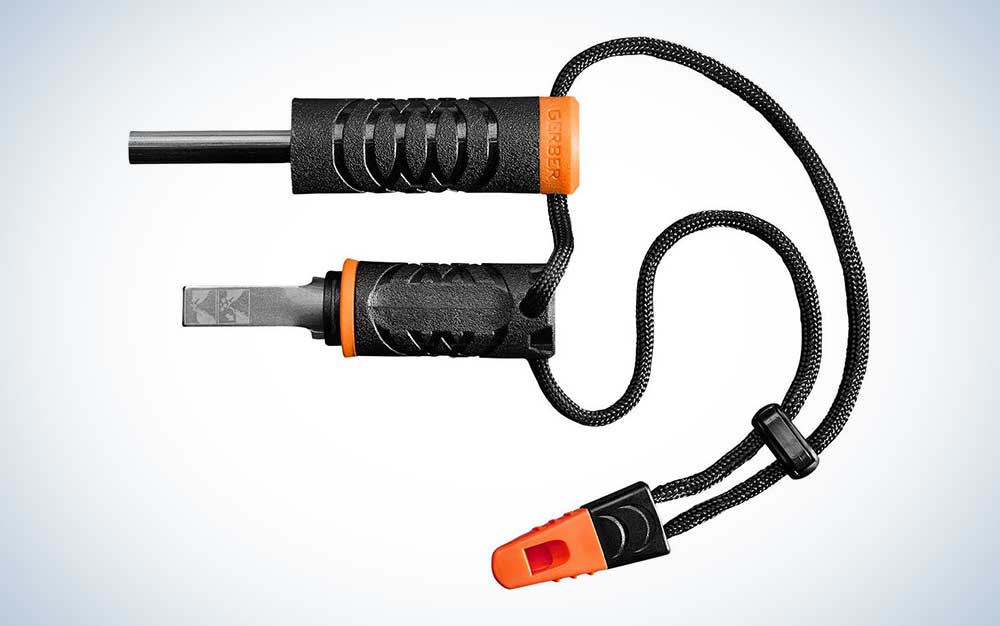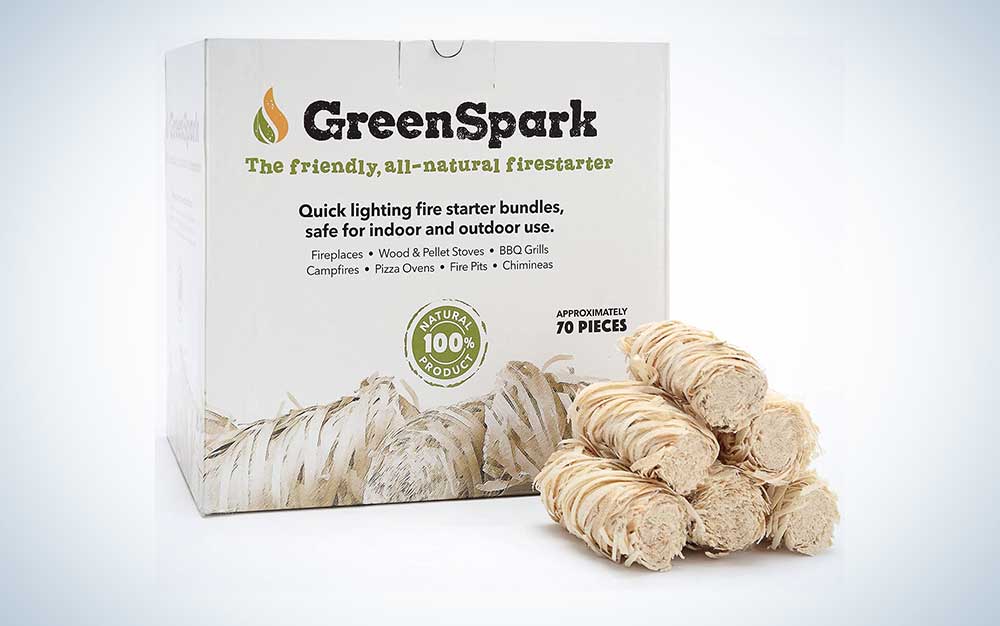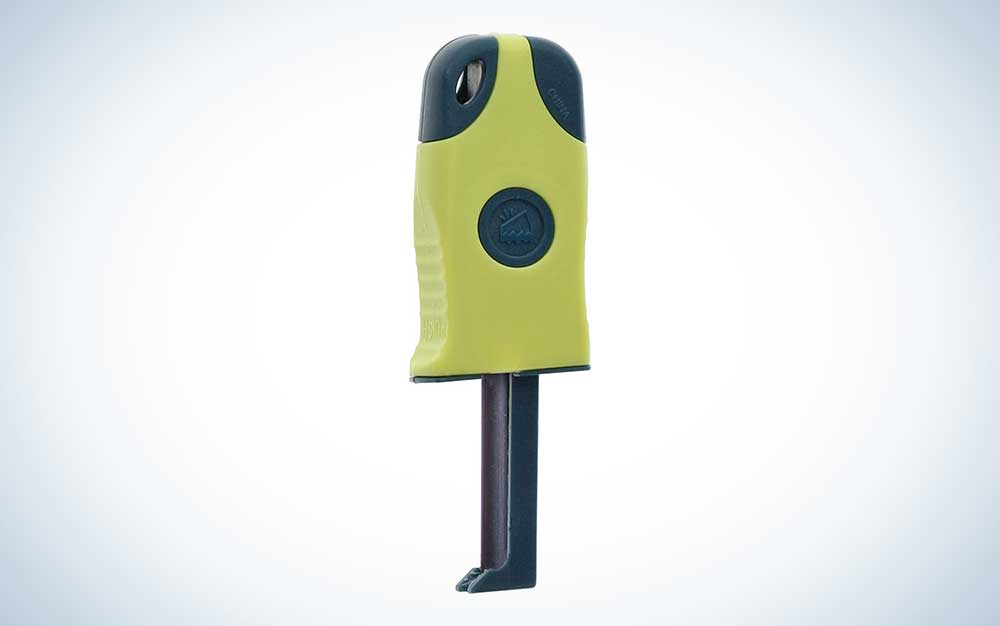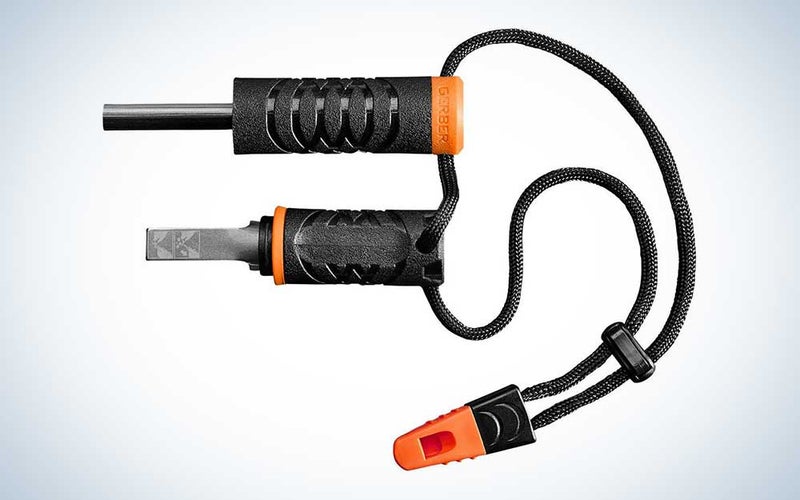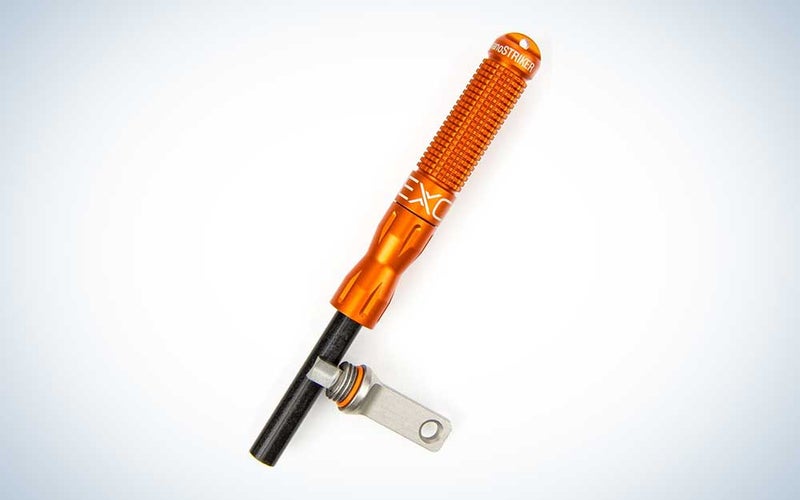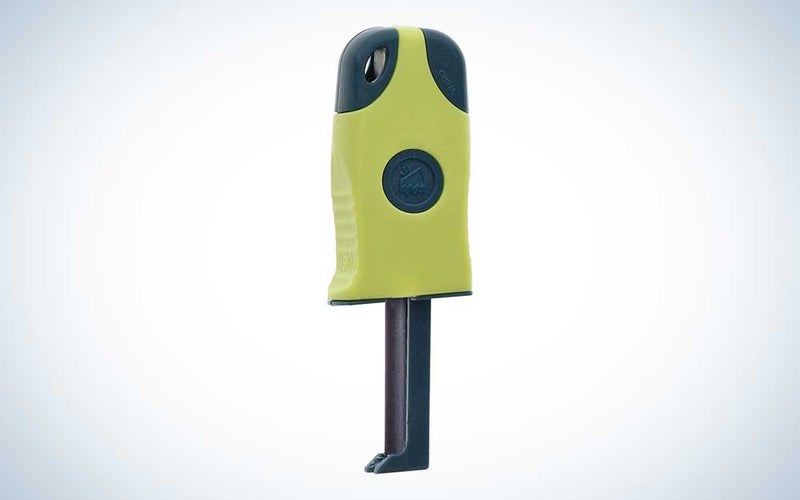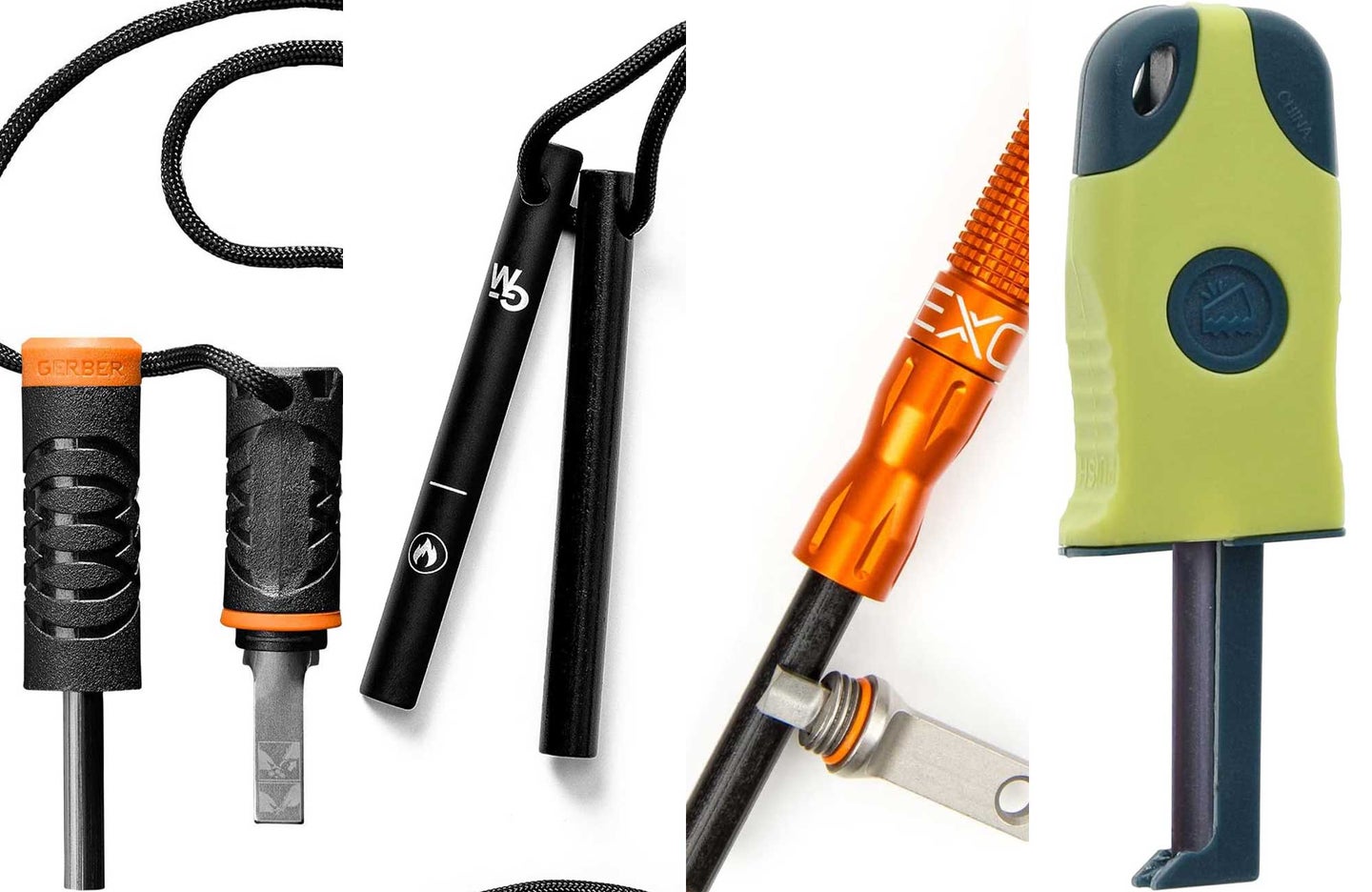
We may earn revenue from the products available on this page and participate in affiliate programs. Learn more ›
Whether building a fire outdoors or starting one in your wood oven or fireplace, a fire starter makes it easy to get a small flame going. You can’t just hold a lighter to a log and wait. To build a blaze, you need to start small, then add your larger pieces of wood until you have a large fire. Problem is, getting that first spark isn’t easy if you’re working in windy or wet conditions. Matches and lighters are no match for these particular elements. Fire starters, however, make fire building infinitely less frustrating. The best fire starters are portable, easy to use, and handy in all sorts of environmental conditions.
- Best overall: Gerber Gear Fire Starter
- Best ferro rod: Wolf and Grizzly Fire Set
- Best for fireplaces: GreenSpark Firestarters
- Best for camping: Exotac nanoSTRIKER XL
- Best budget: ust Sparkie Fire Starter
How we chose the best fire starters
A fire starter can refer to the strikers and rods used to start a fire or the small, flammable objects you can light to encourage your kindling and such to catch flames. We decided to focus on the strikers and rods, with one exception. Our focus is based on “what came first: chicken or the egg” logic: Without a striker and rod fire starter, you cannot use the “small, flammable object” fire starter, especially out in the woods. Additionally, anything can be a “small, flammable object” fire starter technically, from pork rinds to a cotton ball. To find the best firestarters, we looked at reviews, recommendations, and conducted heavy research to separate the ones that sparked our interest from those that were a little dim. I’m also a proud former Girl Scout and pride myself on my fire-starting and building abilities.
The best fire starters: Reviews & Recommendations
A fire starter is a handy camping gadget that can do double duty when you’re at home. And, if you have a fire pit in your backyard, you don’t have to worry about finding a lighter that you can use safely. One of our picks should get your fire going.
Best overall: Gerber Gear Fire Starter
Gerber Gear
Specs
- Material: Ferro rod, steel striker, nylon cord, plastic
- Waterproof?: Yes, IPX4
- Lifespan: N/A
- Size: 8 x 6 x 1 inches
Pros
- Bonus features
- Portable
- Easy-to-use
Cons
- Lanyard could be better
Maximize your backpack storage with this fire starter—the cargo shorts of camping gear. The ferro rod is compact, and an included handle gives you a great grip. Plus, the material itself is easy to work with. The included steel striker has directions right on it, so you’ll never forget how to use it. Bonus features like built-in storage for tinder and a 100-decibel emergency whistle make this choice stand out from the pack. If you’re thinking, “What about using the lanyard as tinder in case?” you’ll be out of luck. It’s not recommended for that, although some fire starters do have that feature. All in all, it’s a well-designed fire starter we feel comfortable stowing in our glovebox or side pocket.
Best ferro rod: Wolf and Grizzly Fire Set
Wolf and Grizzly
Specs
- Material: Ferrocerium, steel, nylon, jute
- Waterproof?: N/A
- Lifespan: Around 20,000
- Size: 3.94 x 0.43 x 0.45 inches
Pros
- Paracord can be used as tinder
- Packable
- Steel striker can be sharpened for continued use
Cons
- Some reviews say it’s best for experienced outdoorspeople
If you’re looking for a long-lasting fire starter, consider this simple Wolf and Grizzly fire set your dream come true. Its curved steel striker can nestle against the ferro rod to create a compact profile, meaning you don’t have to worry about bulk. If you’re out of tinder, you can use a knife or the striker to access the jute inside the parachord lanyard. Its 20,000-strike lifespan means you’ll pass it on before reaching its expiration date. And, you can resharpen its steel striker like you do with a multitool, meaning it’s less likely to need replacing. Some reviews say it’s best for outdoorsy folk, but others disagree, blaming it on user error. Regardless, you’ll be glad to have this ferro rod with you while camping.
Best for fireplaces: GreenSpark Firestarters
GreenSpark
Specs
- Material: Wood wool, palm wax
- Waterproof?: Yes
- Lifespan: 8-10 minutes in fire
- Size: 1-inch
Pros
- Compact
- Can use in multiple settings
- Eco-friendly materials
Cons
- Must be dry to light
Here is that exception we were talking about earlier. Based on what you’re lighting, it might feel more comfortable just to use a match or lighter to ignite a fireplace. All those sparks flying create a safety hazard; you don’t want to set off your smoke alarm when you don’t have to. Instead, you’ll need a fire starter that acts as tinder to help your larger pieces of wood catch fire. This eco-friendly fire starter is made from salvaged pine trees and technically never expire. They’re waterproof, but you must ensure they’re dry before lighting. If they do come into contact with water, they take around 10 minutes to be usable. You can also use them in wood stoves, grills, fire pits, and more.
Best for camping: Exotac nanoSTRIKER XL
Exotac
Specs
- Material: anodized aluminum body, ferrocerium rod, tungsten carbide striker
- Waterproof?: Works when wet
- Lifespan: 3,000 strikes
- Size: 3.65 x 0.43 x 0.43 inches
Pros
- Flammable lanyard
- Small enough to put on keychain
- Very compact
Cons
- Might be too small for large hands
Packing light is no problem with the Exotac nanoSTRIKER XL. This extra small fire starter creates a shower of sparks that supercedes its size. Its included striker screws on, meaning you won’t have to take apart your meticulously packed backpack looking for a single part. It’s also .5 ounces, meaning you can use that extra weight to bring a thicker sleeping pad. The ferro rod is replaceable, and you can use the included lanyard as tinder in emergencies. You can even use it when wet. Whether in your pack or emergency kit, the Exotac nanoSTRIKER XL will perform in all kinds of conditions. If you have large hands, it may be a little cumbersome to use.
Best budget: ust Sparkie Fire Starter
ust
Specs
- Material: Flint, plastic
- Waterproof?: Works in wet conditions
- Lifespan: More than 100 strikes
- Size: 6 x 5 x 2 inches
Pros
- Works in adverse weather conditions
- Can use one-handed
- Lightweight
Cons
- Not the most long-lasting fire starter
Lighting a fire doesn’t get much easier or cheaper than this, folks. You can operate the ust Sparkie with one hand. Simply press a button to expose the flint bar and press down toward your tinder. Bam! That’s it! All for around $10! However, it only lasts for around 100 sparks. If you have some extra change to spend and love the Sparkie concept—or you’re a more experienced camper—consider upgrading to the BlastMatch, its beefier older sibling, which lasts for 4,000 strikes. This is a flint-based fire starter, so you also won’t get as much longevity compared to a ferro rod.
What to consider when buying the best fire starters
Fire starters are not a one-size-fits-all object. They have a common goal of helping tinder catch aflame, but you might be better off with one over another based on features. Some are better for casual, indoor use, while others are more ruff and rugged. Here’s how to separate the duds and phonies from the fabulous fire starters:
Types of fire starters
There are three main types of fire starters: Flint and steel, Ferrocerium rods (ferro rods), and magnesium bars.
The flint and steel combo is the tryest and true-est of all the fire starter options. The “flint” can be any hard, sedimentary rock like quartz and chert. The steel striker is heat-treated. You can even use any metal that has a high amount of carbon in it, like old rake teeth and garage door springs. When the striker comes in contact with the flint, tiny particles released from the metal oxidize and ignite when exposed to oxygen. Sparks from flint and steel can be dull, but this fire starter is the easiest to find. You’ll get the best results if you use it with char cloth.
Ferrocerium rods, or ferro rods, produce incredibly hot sparks and make quick work of lighting dry tinder. If you don’t have a striker on hand, you can use the back of a knife. Ferro rods are less uniform compared to flint and steel. They’re made with different metals—particularly cerium, lanthanum, and iron—and the percent of each affects its performance. A softer ferro rod doesn’t have a long shelf life, but it’s easier to use and produces more sparks. When using a ferro rod, any dry, highly flammable material, like birch bark, cotton, and tiny sticks, makes for excellent tinder.
Magnesium bars come with a ferro rod attached to the top. You shave off parts of the magnesium bar onto the nearby tinder pile, which will ignite when it comes into contact with a spark from the ferro rod. It takes a large amount of magnesium to create a flame that lasts long enough to light nearby tinder, so we recommend just sticking with a ferro rod.
Activity
If you’re car camping, van lifing, or just hanging out in a camper or RV, you can get away with a heavier fire starter, since pack weight isn’t a concern. However, backpackers will want to choose something light, like the Exacto nanoStriker. Extra ounces add up to pounds, which is more weight to bear on the hike. This is important, especially if your hike is over days, not hours.
If you’re looking for something to help light your fireplace or grill, the world is your smoked oyster. Like the car camping/RV/camper camp, you can simply bring out what you want to use. You can also use a utility lighter—something those camping, unfortunately, don’t have the luxury to bring along.
Ease of use
Some fire starters, like the ust Sparkie, only need a downward push to create sparks. Flint and steel and ferro rods require a bit more finesse, although the former is more difficult to use than the latter. If you’re a beginner, consider a ferro rod, the Sparkie, or even an electric lighter. If you’re well-versed in the language of the outdoors, you can forage for your own flint … or you can just buy one that’s more technical (e.g., a compact fire starter built for backpacking).
FAQs
Q: How does a fire starter work?
It depends on the fire starter you’re using. Those like the ust Sparkie just need some force to produce sparks. The ones you will come across use a steel striker and ferrocerium, magnesium, or flint. Good old-fashioned friction helps create a shower of sparks that will hopefully land on your tinder (not that one) to start a fire.
Q: Do fire starters expire?
Fire starters are long-lasting. Instead of “expiring,” you’re generally faced with a finite number of strikes before the rod loses its effectiveness. That number is usually in the thousands. Unless you’re literally living outdoors, a fire starter is often a one-time purchase.
Q: How do I use a fire starter?
Using a fire starter can take some practice, but it’s easy to get the hang of it. Depending on the rod material, you first have to scrape off the protective layer that comes with a brand-new rod. If you’re using a magnesium rod, you’ll want to scrap off some magnesium, then add some tinder on top. Then, take a steel striker or a knife and position it close to your tinder pile. Add some pressure, quickly scrape the steel across the rod, and watch the sparks fly.
Final thoughts on the best fire starters
- Best overall: Gerber Gear Fire Starter
- Best ferro rod: Wolf and Grizzly Fire Set
- Best for fireplaces: GreenSpark Firestarters
- Best for camping: Exotac nanoSTRIKER XL
- Best budget: ust Sparkie Fire Starter
A fire starter isn’t a one-trick pony. You can use it on camping trips, in your own backyard, and even in your own home if your butane lighter is nowhere to be found. Plus, they can be a perfect addition to your emergency kit. They’re built to last and are generally inexpensive. Don’t wait until the moment you need one to click “add to cart.”
Why trust us
Popular Science started writing about technology more than 150 years ago. There was no such thing as “gadget writing” when we published our first issue in 1872, but if there was, our mission to demystify the world of innovation for everyday readers means we would have been all over it. Here in the present, PopSci is fully committed to helping readers navigate the increasingly intimidating array of devices on the market right now.
Our writers and editors have combined decades of experience covering and reviewing consumer electronics. We each have our own obsessive specialties—from high-end audio to video games to cameras and beyond—but when we’re reviewing devices outside of our immediate wheelhouses, we do our best to seek out trustworthy voices and opinions to help guide people to the very best recommendations. We know we don’t know everything, but we’re excited to live through the analysis paralysis that internet shopping can spur so readers don’t have to.
The post The best fire starters for camping and fireplaces appeared first on Popular Science.
Articles may contain affiliate links which enable us to share in the revenue of any purchases made.




